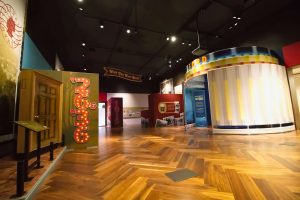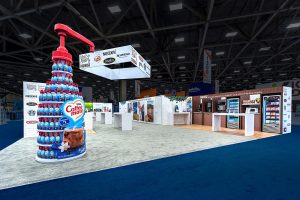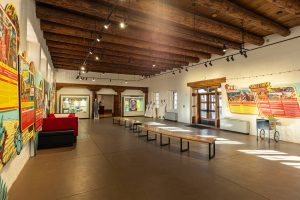Interpretive plans are vital, living, breathing documents used to lay the groundwork for institutions such as museums or education centers. They define the goals, objectives, audience, mission, and vision. Stakeholders and the design team work together to identify themes and subthemes and map the visitor experience. This document plays a critical role in taking a space from concept to reality.
It’s risky to design and build a space without an interpretive plan. The design team guides you and your stakeholders through every aspect of the space – from your visitor’s first impression in the parking lot to what your visitors remember once they are home. An interpretive plan establishes credibility and puts stakeholders and the design team on the same page.
“Through this process, the ultimate goal is to make connections with the audience visiting the exhibit or space. It goes back to the question asked in the beginning; what do we want them to think, feel, or do,” said Jerry Spangler, Vice President of Project Management for Exhibit Concepts.
When fundraising for a space, an interpretive plan is an investment that gives validity to the design partner’s methodology and process. “Donors or organizations issuing grants, of course, expect you to have experience in this game,” said Matthew Brandeberry, Senior Designer for Exhibit Concepts. “An interpretive plan proves the designer’s methodology. You can set it down in front of anyone, and they’re able to understand and see the institution’s vision.”

In some cases, it allows stakeholders to revisit or crystallize their institution’s identity. “Some go through this process and prior to that, may not have taken a concrete look at themselves. It gives them a chance to revisit their identity and intent, and it gives us the chance to create interesting, informative conversations that spark that,” said Brandeberry.
The process for creating an interpretive plan will vary by partner. Exhibit Concepts approaches interpretive planning in two phases. First, an internal workshop is held between our teams and stakeholders, which is an intensive workshop that establishes the goals, objectives, target audience, and layout of the space.
In the second workshop, we work with the museum’s stakeholders to identify themes and subthemes, potential media approaches, and mapping the experience. In detail, our team runs through each section of the plan and addresses questions or concerns. Before the meeting wraps-up, we verify approval on each part of the plan and following the meeting, make adjustments, and submit the final version.
No two interpretive plans will be formatted the same, but there are fundamental deliverables you should expect from potential design partners. When an interpretive plan is hot off the press, it should include the following:
Table of Contents
The Table of Contents gives readers an overview of the plan at a glance. Especially when referencing the plan after approval, it’s helpful to know where you’ll find specific sections you might need.
The Introduction
In the Introduction of an interpretive plan, your design partner will define interpretive planning and outline the importance and benefits. This section is especially helpful for justifying the methodology and investment to stakeholders.
Planning Overview
The visitors, goals, and outcomes are defined, and the experience is mapped. This section is the heart of the plan, as all later methodology will tie back to the identified goals and outcomes outlined here.
“You’ll continue to refer back to the goals in an interpretive plan. Everything is designed with the institution’s principles in mind. This is what keeps everyone in line and creates consistency,” said Brandeberry.
Design & Content
The interpretive planner may provide theories and methodologies that will support the proposed design. Once the methodologies are defined, the themes and subthemes are described and solidified. Based on initial conversations with the institution, the interpretive planner will provide visual inspiration to showcase the best approach for displaying artifacts and collections in the space. Descriptions providing reasoning for each set of inspiration are equipped to support these suggestions.
Visual inspiration for the architectural style of the space is also provided in this section and will include a schematic plan showing the walkthrough. These plans are not cookie-cutter and may take on a variety of forms that will adequately characterize the identified themes and subthemes of the space. Outside of telling the stories, critical components of the space, such as restroom placement and architecture that make the space accessible to visitors that are disabled, are addressed.
Requirements, Parameters, and Implications
The interpretive planner will go over any restrictions or regulations that need to be considered, especially if the space is government regulated. If you’re a state-run institution, what rules and regulations would we need to follow? Are there political or social boundaries that need to be respected? These are a few of the questions that might be addressed.
Implications and parameters connected to the logistics of the space are also discussed. For example, if the space includes A/V or technology engagements and the staff is primarily older volunteers, the engagements need to be placed where they can reach it without bending over or reaching up. For both the staff and visitor, recommendations for technology that is easy to use is recommended. The staff and training needed to maintain the space are discussed.
Other logistical implications related to the exhibits or objects are planned in this section. For example, if one room in the space is available to the public for event rentals, exhibits within the room should not be fixed. In this case, placing wheels on the display cases will allow staff to quickly and safely roll the exhibits away to prepare for set-up.
Project Overview
Planning the design, fabrication, and installation of the space are discussed here. The timeframe for each step in the process is established, and the budget is reviewed.
An interpretive plan is a substantial investment that provides both the institution and design partner with credibility. The document puts everyone on the same page and proves the method behind the magic. It crystallizes an institution’s identity, messaging, and goals and ensures those will be clear and inspiring to visitors.
If your space is ready to spring to life, choosing a partner with this offering is a critical step in the process.











